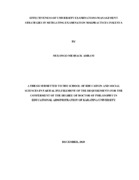| dc.description.abstract | The purpose of the study was to assess the effectiveness of university examinations
management in mitigating examination malpractices in Kenya. The specific objectives
were to; establish the prevalence of examination malpractices among male and female
students in universities in Kenya, assess the adherence by universities to the examination
regulatory frameworks in Private and Public universities in Kenya, examine the
effectiveness of strategies used to control examination malpractices in Private and Public
universities in Kenya and assess the challenges affecting the control of examination
malpractices in Public and Private universities in Kenya. The study sought to find if there
was significant difference in prevalence of examination malpractices between male and
female students, adherence to examination regulatory frameworks by public and private
universities, effectiveness of strategies used to control examination malpractices between
the public and private universities and challenges affecting the control of examination
between the public and private universities. The study was guided by Bandura’s
Self-Efficacy theory. The target population was 40033 respondents. The study was based
on the descriptive survey research design. A total of 390 participants were sampled using
Kathuri and Pals’ sampling table. Purposive, stratified and simple random sampling
techniques were used. Data collection instruments were questionnaires and an interview
schedule. Cronbach’s Alpha Coefficient was calculated to establish the reliability of the
instruments, which yielded r=0.79 and r= 0.77 for students’ and examination officers’ questionnaires respectively. Opinion of experts from the department of education was
used to validate the instruments. Data was analyzed using both the descriptive and
inferential statistics, precisely the t-tests. Results showed that 50.4% of respondents
agreed that students possess unauthorized materials 49.6% agreed that students copy
examinations and 50% indicated that they girrafed on others and these were the most
prevalent forms of examination malpractices. Non-adherence to examination regulatory
frameworks was affirmed by 51.3% of respondents while frisking was 64.5% of
respondents. The t-tests calculated revealed that the prevalence of examination
malpractices between male and female students in universities in Kenya was largely the
same, the adherence to regulatory framework for private and public universities was
largely the same, there was a significant difference in the effectiveness of strategies when
public and private universities were compared and there was a significant mean
difference when public and private universities were compared on challenges affecting
the control of examination universities. Based on the findings, the study recommended
that there was need to strengthen vigilance in the administration of examinations in
universities in Kenya. In addition, there is need for use of Closed Circuit Television
(CCTV) cameras in examination rooms and improved frisking of students. These
recommendations, if implemented, will greatly help in formulation of policies towards
the mitigation of examination malpractices in | en_US |
